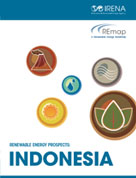Renewable energy prospects: Indonesia
 Indonesia is the largest country in the Association of Southeast Asian Nations (ASEAN), accounting for around two fifths of the region’s energy consumption. Energy demand across the country’s more than 17,000 islands could increase by four fifths and electricity demand could triple between 2015 and 2030. While reliance on domestic coal and imported petroleum products has grown, Indonesia has started adding more renewables to its energy mix. The country has set out to achieve 23% renewable energy use by 2025, and 31% by 2050. REmap – the global roadmap from the International Renewable Energy Agency (IRENA) – addresses this challenge, presenting a range of technology and resource options, along with key insights on the opportunities and challenges ahead. As this REmap country report shows, Indonesia could feasibly exceed its current goals and deploy even more renewables. In fact, the country could reach its 2050 target two decades sooner – by 2030. The benefits of such accelerated uptake would greatly outweigh the costs. Compared to current plans and policies, it would cut net energy system costs and avoid air pollution and carbon-dioxide emissions – enough to save up to USD 53 billion per year by 2030 in economic terms. This amounts to an estimated 1.7% of Indonesia’s gross domestic product in 2030. Harnessing this potential, however, requires over USD 16 billion of investments per year in renewable power capacity over the period to 2030. The report outlines three main areas where the country could take action to realise this opportunity: Intensify efforts to meet growing electricity demand by capturing renewable energy resource potential; Focus more on developing renewables for industry, buildings and transport; Develop an integrated and comprehensive bioenergy programme to ensure sustainable development and use of this vital energy source.
Indonesia is the largest country in the Association of Southeast Asian Nations (ASEAN), accounting for around two fifths of the region’s energy consumption. Energy demand across the country’s more than 17,000 islands could increase by four fifths and electricity demand could triple between 2015 and 2030. While reliance on domestic coal and imported petroleum products has grown, Indonesia has started adding more renewables to its energy mix. The country has set out to achieve 23% renewable energy use by 2025, and 31% by 2050. REmap – the global roadmap from the International Renewable Energy Agency (IRENA) – addresses this challenge, presenting a range of technology and resource options, along with key insights on the opportunities and challenges ahead. As this REmap country report shows, Indonesia could feasibly exceed its current goals and deploy even more renewables. In fact, the country could reach its 2050 target two decades sooner – by 2030. The benefits of such accelerated uptake would greatly outweigh the costs. Compared to current plans and policies, it would cut net energy system costs and avoid air pollution and carbon-dioxide emissions – enough to save up to USD 53 billion per year by 2030 in economic terms. This amounts to an estimated 1.7% of Indonesia’s gross domestic product in 2030. Harnessing this potential, however, requires over USD 16 billion of investments per year in renewable power capacity over the period to 2030. The report outlines three main areas where the country could take action to realise this opportunity: Intensify efforts to meet growing electricity demand by capturing renewable energy resource potential; Focus more on developing renewables for industry, buildings and transport; Develop an integrated and comprehensive bioenergy programme to ensure sustainable development and use of this vital energy source.
